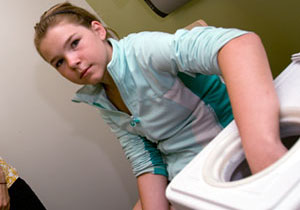 |
| Eleven-year-old Jessie McLaughlin puts her hand in water for the cold water task. ‚ÄúI didn‚Äôt mind it,‚ÄĚ she remarked later, holding on to her Junior Scientist certificate. ‚ÄúBesides, it‚Äôs kind of neat to take part in real research.‚ÄĚ (Bruce Bottomley Photo) |
A few ĻŻĹī ”∆Ķ graduate students are putting out a call for ‚Äújunior scientists.‚ÄĚ They‚Äôre looking for kids, ages eight to 14, to provide assistance with their research projects.
But there is a hitch: they can’t promise it won’t hurt, even if just a little bit.
Melanie Noel and Mark Petter are part of Dr. Christine Chamber’s research team at the Centre for Pediatric Pain Research laboratory at the IWK Health Centre. They’re seeking young volunteers for two studies which examine how children’s feelings affect how they experience pain over time.
‚ÄúWe need the help of healthy kids in a fun, lab setting,‚ÄĚ says Ms. Noel, a PhD student in clinical psychology. ‚ÄúThere are some questions to answer, a few activities to do and then there‚Äôs a cold water task ‚ÄĒ it‚Äôs a safe way for us to look at pain.‚ÄĚ
The cold water task entails the child submersing their hand in 10-degree Celsius water for a maximum of four minutes. But the kids are in complete control of the task; if they find it uncomfortable, they can remove their hand at any time.
‚ÄúThe cold is¬†comparable to¬†reaching your hand into a cooler and taking out a drink or making a snowball with your bare hands,‚ÄĚ says Ms. Noel, who is interested in what coping skills children employ when dealing with pain. Children get a nice crisp $20 bill and a junior scientist certificate for participating.
‚ÄúIt‚Äôs great for kids who are interested in science. They find it really interesting and it does help us out immensely,‚ÄĚ says Mr. Petter, also a PhD student in clinical psychology. One of his studies focuses on distraction techniques. While the child has a hand in the cold water, they‚Äôre listening to audio tapes evoking the imagery of a specific place ‚Äď a beach where waves are lapping on the shore, for example. His second study, however, is almost the exact opposite: a ‚Äúmindful attention‚ÄĚ audio tape directs the child to focus on the sensations he or she is experiencing.
‚ÄúThere are some kids who prefer to watch the needle going in,‚ÄĚ says Mr. Petter. ‚ÄúBut there are others who find distraction works for them ‚Äď they‚Äôll look away or listen to music.‚ÄĚ
Participating in the research can take anywhere from a half hour to an hour, depending on the study. The students add their time is flexible, and can accommodate junior scientists on weekdays, evenings or weekends ‚ÄĒ ‚Äúwhatever works for families, works for us,‚ÄĚ says Ms. Noel.
Interested in learning more? You can give the lab a call at 470-6906.
LINKS: |
